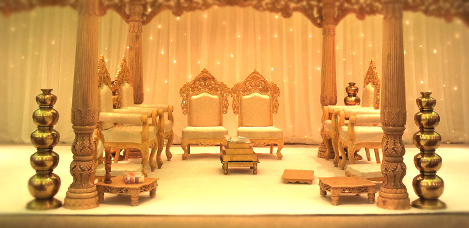Decorations and tradition are important for almost all wedding ceremonies across the world. Not only does the attire of the bride and groom matter but the location, rituals and all the fittings that go with the day’s festivities. In Asian weddings, particularly for Indian ceremonies, one of the most important parts is the mandap.
This is a covered structure that usually has a supporting frame and pillars, decorated colourfully and which carries the royal chairs where the betrothed couple sit and the marriage ceremony takes place. Traditional mandaps were often decorated with mango and banana leaves with pots of water or kalashas but modern structures also incorporate bright fabrics and flowers as well as colourful lights.
Asian wedding mandaps can vary from simple structures to lavish affairs and are often provided by asian wedding event companies who have a variety of different models available for their customers. In India and locations around the world where Asian couples are intending to marry, the mandap is a vital part of planning for the ceremony and it’s important to get just right.

History
The traditional Hindu wedding we know today has its origins in the past and many of the rituals and symbols have come down through the generations virtually unchanged. The mangalsutra or wedding necklace is one of these, placed around the bride’s neck by the groom to ensure good luck and prosperity for the future. The mandap, with its four pillars signifying the parents of the bride and groom, and the central ceremonial fire, all represent a sacred place where the formal wedding ceremony takes place.
India, of course, is a large and diverse place and how the mandap is used for the wedding ceremony varies slightly from community to community. The wedding is carried out under the guidance of a Hindu Brahmin priest who has studied the scriptures and can ensure the ceremony runs smoothly. In some ceremonies, the groom arrives at the mandap and the bride then makes her grand entrance, usually escorted by uncles or brothers. In others, the groom is met by his in-laws who perform a traditional dance.
Hiring a Mandap
Most Indian couples who are planning to marry will hire their mandap, whether their wedding is taking place in India itself or another country around the world. The choice of style and elegance of the mandap forms an integral part of the whole event and making sure you have the perfect design is usually top of everyone’s list.
There is, as with many other hire services, a lot of difference between companies supplying mandaps. Some are on the less expensive side which means they are made of cheaper fibre glass and are perhaps less ostentatious. At the other end of the spectrum are the lavish mandaps that include ornate wedding chairs and decorations.
You can find mandap hire companies in almost every country in the world now where there is an Indian community. Many combine the traditional mandap with a marque or tent hire that means the whole ceremony can take place in any location the family want.
In the UK alone there are several mandap hire companies that provide a range of traditional and more modern stages for the perfect Asian or Indian wedding. If you want access to all the best wedding services in your area, download our Asian Directory in a mobile app or browse our website today – get everything you need right at your fingertips. It’s the perfect way to find the Mandap you want for your big day in West Bromwich, Birmingham, West Midlands, London – any area of UK.
For a range of Asian wedding Tent hire, Marquee hire and Mandaps browse our free directory here https://list.asiandirectoryapp.com/c/Mandap